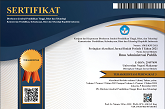Bureaucratic Reform: A Case Study in Secretariat General of the Ministry of Education and Culture
(1) Sekretariat Jenderal Guru dan Tenaga Kependidikan
(*) Corresponding Author
DOI: https://doi.org/10.26858/jiap.v9i2.10799
Abstract
Keywords
Full Text:
PDFReferences
Aji, M. Q. W., Heru, B., & Turmudzi, D. (2013). Impact of bureaucracy reforms and cultural organization to the performance of organization secretariat general ministry of education and culture. Pasundan University.
Aneta, A., Aneta, Y., & Dama, H. (2018). Institutional Problems in Regional Public Services. Jurnal Ilmiah Ilmu Administrasi Publik, 8(2), 79–86. https://doi.org/10.26858/jiap.v8i2.7877
Caiden, G. E. (2014). Administrative reform comes of age (Vol. 28). Walter de Gruyter GmbH & Co KG.
Dwiyanto, A. (2013). Mengembalikan kepercayaan publik melalui reformasi birokrasi. Gramedia Pustaka Utama.
Cheung, A. B. L. (2005). The politics of administrative reforms in Asia: Paradigms and legacies, paths and diversities. Governance, 18(2), 257–282. https://doi.org/10.1111/j.1468-0491.2005.00275.x
Gibson, Ivancevich., Donnely. (1997) Organisasi, Perilaku, Struktur, Proses, alih bahasa Wahid, Jakarta: Erlangga.
Kassay, A. (1998). Administration and efficiency - bureaucratic reform: The case of Jordan. Mediterranean Politics, 3(3), 52–62. https://doi.org/10.1080/13629399808414665
Lee, H. B., & Samonte, A. G. (Eds.). (1970). Administrative reforms in Asia. Eastern Regional Organization for Public Administration.
Miftah, T. (2008). Birokrasi Pemerintah Indonesia di Era Reformasi. Edisi Pertama, Cetakan ke-1, Kencana Pranada Media Group, Jakarta.
Morgan, G. (1997). Images of organization. Thousands Oaks. Cal.: Sage Publications
Morgan, G. (2011). Reflections on images of organization and its implications for organization and environment. Organization and Environment, 24(4), 459–478. https://doi.org/10.1177/1086026611434274
Mukhtar, M. I. (2015). The public manager, the structure of public institution, and implementation: The 2002-2012 finnish senior bureaucratic manager reform. Teaching Public Administration, 33(1), 40–61. https://doi.org/10.1177/0144739414532283
Paskarina, C. (2017). The making of competitive bureaucracy: A case of bureaucratic reform in West Java province. Cogent Social Sciences, 3(1), 1–13. https://doi.org/10.1080/23311886.2016.1273748
Prasojo, E., & Kurniawan, T. (2008). Bureaucracy Reform and Good Governance: the case of the best practices from several regions in Indonesia. Symposium A Quarterly Journal In Modern Foreign Literatures, 1–15. Retrieved from https://scholar.google.com/scholar?oi=bibs&cluster=360656420083251686&btnI=1&hl=id
Robbins, S. P. (1998). Organisation Behaviour. Eight Edition.
Robbins, S. P. (2003). Perilaku Organisasi.(judul asli: Organizational Behavior Concept, Controversies, Applications 8th edition) Jilid 1. Penerjemah Hadyana Pujaatmaka. Jakarta: PT. Prenhallindo.
Robbins, S. P. (2009). organisational behaviour in Southern Africa. Pearson South Africa.
Robbins, S. P. (1990). Organization Theory: Structures, Designs, And Applications, 3/e. Pearson Education India.
Sobirin, A. (2007). Budaya Organisasi: Pengertian, makna dan aplikasinya dalam kehidupan organisasi. Yogyakarta: UPP, STIM YKPN.
Sondang, S. P. (1995). Teori Pengembangan Organisasi. Jakarta, Bumi Aksara, Sinar Grafika Offset.
Tandi Datu, T., & Nawawi, H. J. (2014). Implementation of good governance and bureaucratic reform in Indonesia. International Journal of Academic Research, 6(3), 5–9. https://doi.org/10.7813/2075-4124.2014/6-3/b.1
Tjokroamidjojo, Bintoro. (1997). Perencanaan Pembangunan. Jakarta: Gunung Agung
Turner, M., & Hulme, D. (1997). Governance, administration and development: Making the state work. Macmillan International Higher Education.
Yusriadi, & Misnawati. (2017). Reformasi Birokrasi dalam Pelayanan Publik. Jurnal Ilmiah Ilmu Administrasi Publik, 7(2), 99–108. Retrieved from http://ojs.unm.ac.id/iap/article/view/4954
Article Metrics
Abstract view : 1383 times | PDF view : 225 timesRefbacks
- There are currently no refbacks.
Copyright (c) 2019 Muhammad Qudrat Wisnu Aji

This work is licensed under a Creative Commons Attribution 4.0 International License.
Diterbitkan oleh:
Program Studi Ilmu Administrasi Publik
Program Pascasarjana Universitas Negeri Makassar
JIAP Index By:

This work is licensed under a Creative Commons Attribution 4.0 International License.









